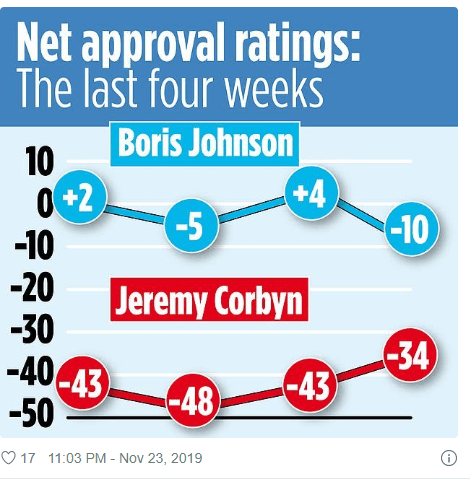
Yougov
“On Monday of this week, the man some people have begun referring to as “Dr. Doom” sits in a German restaurant in London, stares at his coffee and says, “I wish I hadn’t been right.”
Then he offers another prophecy: “I suspect we might have Boris Johnson for 10 years, maybe longer.”
De Spiegel interview with the former British ambassador Sir Ivan Rogers
We are nearly half way through this general election and it seems like a good time to provide an update on where we are heading.
In 2016, I wrote that “the Conservative Party is moving to bring on-board Labour voters, just as Donald Trump is doing with blue-collar Democratic voters, in the United States. You may hear a lot more in the coming years of the May Labourites and how they will bring an electoral landslide for the Tories at the next general election.” The Tories under the than Prime Minister May were embracing the rhetoric of a centre-left economic policy agenda and as a consequence enjoyed soaring polling ratings.
We know what happened next. That rhetoric failed to be converted into policy. The June 2017 snap general election was a disaster for the Tories and resulted in a hung parliament.
This time round, under their new leader Boris Johnson, it looks like the Tories have a better chance of capturing those ex-Labour blue-collar voters in the election on 12th December 2019. Current polling shows the Tories ahead with a 14% lead in the national polling

Politico
Labour’s policy manifesto published earlier this week was a radical socialist programme which would overturn the 1979 political economy. The numbers involved are eye watering and it is questionable how credible much of the proposed policies are, whether in terms of their implementation or costings.
Focus group feedback indicate that this, far more radical manifesto, simply fails to pass “the smell test” with voters. The proposed four-day week idea, in particular, goes down badly with voters. Labour have missed the lesson of 2017 – yes to radical change of the status quo but it must be done in a way that is sellable on the doorstep and comes across as “credible” to the wider electorate.
The Tories, in contrast, have smartly learned the lessons of their electoral near-death experience in 2017. They have ditched the commitments to austerity and have promised significant investment across public services and infrastructure. The key retail propositions have been tested to destruction with focus groups and their overarching message of “get Brexit done” was literally copied from feedback from disgruntled voters. The Tory campaign has been disciplined, ruthless and much better focused on their key target seats.
One metric I am following closely is the net satisfaction in leaders’ ratings. This FT chart shows the huge gulf between the two leaders and the Tories need to maintain that healthy lead in the coming two weeks.

Financial Times
A recent poll suggests that gap is narrowing which, if replicated in other polls, could be a worrying sign for the Tories. However, it could also be an outlier. We will only know once we see further polling in the coming days and weeks. I suspect that the radical Labour manifesto could be having the impact of energising Labour’s core vote even if it hardens existing negative views of Corbyn among the wider electorate.

Political betting.com
As Eurointelligence noted recently, “the purpose of this manifesto is to fire up the Labour grassroots. We think it might succeed on that score. It is smart politics for Labour to vacate the centre ground and focus on turnout.” The risk of that strategy will be to turn soft Labour voters against the party even if it succeeds in raising the turnout figures for the core demographics of the Labour voting base. Until we see further polls in the coming weeks it will be difficult to precisely forecast whether Labour’s strategy is working or not.
So, to summarise, I’m sticking with my forecast that the Tories should get a solid comfortable majority on 12th December 2019 of 347 seats.
Scottish Conservatives seat tally update
For those readers who took up my advice and placed the bets of the Scottish Conservatives getting a vote tally of between 11 and 15 and 16 plus, things are looking good. The first Scottish poll in a month indicates that the Scottish Conservatives will lose one seat (Stirling) to the Scottish National Party (SNP). This is contrary to the widespread assumption that the Tories would get wiped out at the general election.
Note, though, that the seat projection is based on national polling and doesn’t factor in potential Unionist tactical voting in those marginal Tory-SNP seats. If that occurs, which is what is predicted by the Scottish Labour writer Ian Smart, then the Tories will increase their seat tally in Scotland.
The odds of the Scottish Tories getting over 16 seats is now crashing. A £25 bet would now return “only” £275 rather than over £400 when I recommended the trade a few weeks ago. I expect those odds to narrow further as we get closer to the election as it is clear that momentum is with the Scottish Conservatives.

Coral
It looks likely that the Tories will reach at least the seat tally of between 11 and 15 which will yield a nice profit for those who took the bet. And the prospects of a blow-up rise of their seat tally to 16 or more is increasingly promising.
As always, I look forward to receiving any feedback you might have on my analysis. Stay tuned!
FI